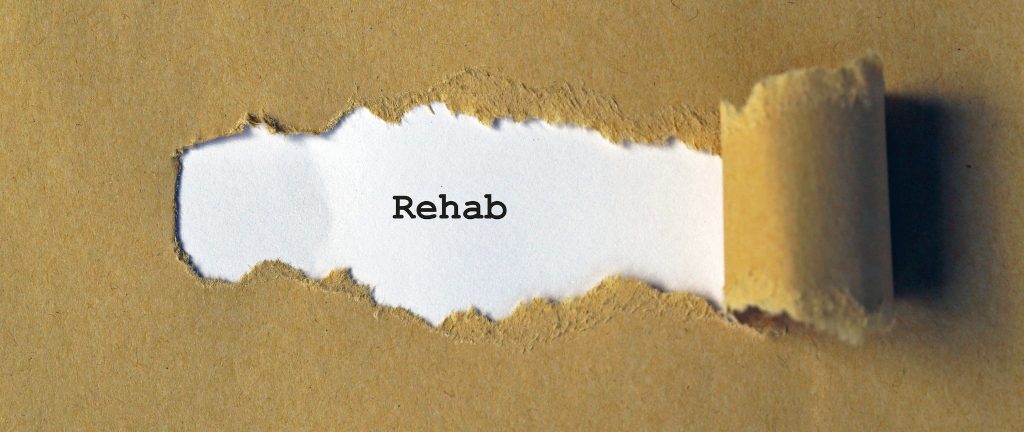Inpatient rehab, which is the most intensive addiction treatment option available, involves living at the facility for the duration of the treatment program. Many such programs offer both holistic and medical care, as well as safe settings for effective recovery. Although inpatient rehab can be beneficial for anyone with a substance addiction, it may be especially helpful for someone with a severe addiction, a co-occurring mental health disorder, co-occurring medical condition, or polysubstance addiction.
What is an Inpatient Rehab Program?
Inpatient rehab is medically managed and monitored care performed either in a hospital or residential setting. These settings provide an environment conducive to recovery so you can avoid relapse. Inpatient facilities staff interdisciplinary teams of health professionals who treat serious mental and physical health issues.2, 7
Certain factors suggest inpatient rehab is the right place to start your addiction recovery treatment. You may need to seek inpatient treatment if you have the following:3
- Dual diagnosis, which means both a mental health disorder and SUD
- Comorbid conditions, which is a medical condition and SUD combined
- Exposure to drugs and alcohol in your home environment
- Lack of support from family or friends to get sober
- High risk of experiencing severe withdrawal symptoms
- Previous relapses
- History of unsuccessful recovery at other treatment levels
- Need for medically monitored detox
Benefits of Inpatient Rehab
Inpatient rehab programs offer benefits that cannot be found in outpatient programs. You may need to separate yourself from your daily life or influences that make it challenging to stop misusing drugs or alcohol. A structured inpatient program in a hospital setting can offer:4
- Environments safe for treatment
- Medication assistance for withdrawal symptoms and cravings
- Accessible doctors, nurses, and clinicians
- Medication and counseling treatment for mental health disorders
- Education on recovery and relapse prevention skills
- Comprehensive, intensive counseling services
- Peer support available on site and in daily support groups
Success rates of inpatient rehab programs are greater in several areas. They are shown to reduce the severity of SUDs, increase abstinence rates at the 2-year follow-up, minimize your substance use, and decrease any cravings you may encounter.5
Programs that treat mental health disorders and other conditions simultaneously with SUDs have been show to:6
- Reduce mental health and substance misuse symptoms
- Increase abstinence
- Decrease emergency room visits
- Improve personal self-esteem
- Engage family in recovery
- Increase skills you need for full recovery
What to Expect in Inpatient Rehab
Inpatient alcohol rehab and inpatient drug rehab include several types of treatment programs, which can vary. You should understand what happens when you enter an inpatient rehab, as well as what program it is, to know what to expect from inpatient treatment.
Intake and Assessment
Intake and assessment focus on getting you the most appropriate level of care based on the information you are willing to disclose. This info includes your symptoms, substance use, social functioning, level of impairment, and more.10 Your assessor determines the level of care you need to move forward based on inclusionary criteria that include:10
- Method of use (e.g., intravenous versus oral consumption)
- Whether you are currently intoxicated
- Dosage
- Frequency
- Any existing periods of sobriety and their duration
- Immediate medical needs such as active withdrawal
- History of withdrawals that get progressively worse
- History of any mental health concerns
- Duration of overall substance use
Assessment happens throughout your treatment. This way, providers can adjust your level of care to help you move forward on the path to recovery.
Detox Services
When you enter inpatient alcohol rehab or inpatient drug rehab, detox may be the first step. When you stop using a substance, uncomfortable, painful, and even life-threatening withdrawal symptoms can arise. Detox is where any withdrawal symptoms are managed. Treatment cannot begin until all substances have left your system. However, detox is only the first step in the continuum of care for inpatient rehab.2
Not everyone needs medically managed withdrawal. However, if you are at risk of seizures or dangerous withdrawal symptoms, you may benefit from medical detox at the inpatient level.2
Inpatient rehab is a level of care you can return to if a lower level is not enough. Many people in the continuum of care graduate from inpatient rehab to outpatient services.2 There may be times when you need more support than what outpatient rehab can offer. Reentering inpatient drug rehab or inpatient alcohol rehab can be a good option. It is okay to return to a more structured program, especially if it helps you avoid a relapse.
If you experience a relapse, that is okay. However, you should return to inpatient rehab as soon as possible after the relapse. Relapses on alcohol and drugs are common and can get out of control if they are not dealt with quickly.
Medication-Assisted Treatment (MAT) for Inpatient Alcohol Rehab
Medications used in inpatient alcohol rehab treatment include:11
- Acamprosate: This medication typically is prescribed on the fifth day of no alcohol use and is taken orally at the same time every day three times a day. It is fully effective in five to eight days. It helps you abstain from alcohol but does not prevent withdrawal symptoms.
- Disulfiram: This medication is taken orally once a day and is meant for those who already have been through detoxification or are in the initial stage of abstinence. If you drink alcohol while taking this medication, you will experience nausea, vomiting, headaches, difficulty breathing, and chest pain in as little as ten minutes. This can last for an hour or longer.
- Naltrexone: This medication blocks euphoria associated with alcohol use. It helps you maintain motivation to remain medication compliant, stay in treatment, and avoid relapses.
MAT prevents relapse by altering receptors in the brain to make alcohol misuse undesirable.7 None of these medications are a cure for alcohol use disorder itself. Rather, they are used to complement behavioral therapies, together addressing the needs of the whole person.
MAT for Inpatient Drug Rehab
Opioids, muscle relaxers, and stimulants require some different detox methods than alcohol. Opioids are sedatives that can cause severe dependence, which can lead to opioid use disorders. Medications to treat opioid dependency include buprenorphine, methadone, and naltrexone.7, 11
Muscle relaxers and antianxiety medications include benzodiazepines. Withdrawal is not as painful as opioids, and weaning off the drug may be recommended. A substitute benzodiazepine is helpful in the detox process. Length of stay may range between one day to a week in a hospital setting, depending on your substance use disorder severity.7
Stimulant use disorder has no FDA-approved medication to combat addiction. Many doctors treat its symptoms as they appear. Examples include antianxiety, antidepressant, and anti nausea medications. It takes less time for stimulants to exit the body, so detox may only last a few days in a hospital setting.7
Behavioral Therapies Used in Inpatient Rehab
These evidence-based therapies are used in inpatient alcohol rehab and inpatient drug rehab. Examples of the most effective behavioral therapies found in both programs include:8
- Cognitive behavioral therapy (CBT): CBT addresses behavioral patterns and processes with short-term treatment goals achieved in group collaboration.
- Contingency management (CM) interventions/motivational incentives: CM reinforces abstinence and other positive behaviors by offering tangible rewards to patients.
- Dialectical behavior therapy (DBT): DBT is a type of CBT that incorporates mindfulness and acceptance.
- Community reinforcement approach (CRA) plus vouchers: CRA is used to treat persons addicted to cocaine or alcohol. A variety of reinforcers and material incentives are used in a 24-week intensive outpatient setting. This method attempts to make sobriety more rewarding or appealing than substance misuse.
- Motivational enhancement therapy (MET): MET involves quick changes spurred by internal motivators to help patients promptly overcome alcohol use. Counseling encourages patients to seek treatment.
- Matrix model: This therapy for stimulants incorporates worksheets, coaching, relationship-building, and drug testing to encourage abstinence.
- 12-Step facilitation therapy: These aid recovery by offering peer support, acceptance, involvement, and a spiritual foundation.
- Holistic and alternative therapies: These include acupuncture, acupressure, yoga, meditation, art, music, equine, massage, nutrition, fitness, etc.
- Family behavior therapy: This provides you and your loved ones with education about the disease of addiction, setting boundaries, enabling behaviors, and how to support your recovery as a family system.
 Doctors Can Help Overcome Opioid Dependency but Patients Are Unaware, Studies Show
Doctors Can Help Overcome Opioid Dependency but Patients Are Unaware, Studies Show
 Teens Prolonging Opioid Use Before and After Surgery, Study Shows
Teens Prolonging Opioid Use Before and After Surgery, Study Shows
 Cannabis Misuse on the Rise Among Older Adults, Study Shows
Cannabis Misuse on the Rise Among Older Adults, Study Shows
 Most Outpatient Mental Health Clinics Don’t Offer Opioid Addiction Meds
Most Outpatient Mental Health Clinics Don’t Offer Opioid Addiction Meds
How to Choose an Inpatient Rehab Center
You may choose the nearest treatment facility or a treatment center that accepts your insurance coverage. If possible, explore other factors when selecting an inpatient rehab. The wrong inpatient experience will make it easier to relapse.
Choosing the right inpatient rehab means asking questions and weighing the answers to see which will benefit you the most in the long run. Questions to ask include:9
- Are the staff licensed or certified? Is the facility licensed or accredited?
- Have any of the therapists had an alcohol or drug use disorder?
- What is the admission process?
- How do they treat withdrawal symptoms?
- What is the average time someone stays on medication?
- What behavioral therapies do they offer?
- How long is the program? What is the average length of stay?
- What aftercare services or programs are offered?
- Can I call my family and friends, and can they visit or attend therapy?
- What do I need to bring with me to inpatient rehab?
- What are the policies of the inpatient rehab center?
- Is the program in a safe neighborhood?
- How do they develop a treatment plan?
- Are treatment plans individualized based on unique needs?
- Do they have references or people to talk to about their program?
- Do they treat mental or physical health conditions as well?
The cost and price of inpatient rehab programs are essential but should not prevent you from getting treatment. Inpatient rehab facilities have access to state and local funding to help you receive treatment. Many offer scholarships. Insurance companies are beginning to cover more inpatient rehab services. You can also choose a payment plan, check into getting a loan, or collect donations from a local church. Inpatient rehab is an excellent investment, and the longer you stay in treatment, the better chances you have of overcoming your alcohol or drug use disorder.
Seeking Inpatient Rehab
There is no better time than right now to learn more about inpatient alcohol rehab, inpatient drug rehab, or both. Make your list of questions to ask an inpatient rehab treatment center, and then call
800-914-7089
(Who Answers?)
to get help today.
Resources
- National Institute on Drug Abuse. (2020). What are Risk Factors and Protective Factors?
- U. S. Department of Health and Human Services. (2016). Chapter 4: Early Intervention, Treatment, and Management of Substance Use Disorders. Substance Abuse and Mental Health Services Administration (US). Office of the Surgeon General (US). Facing Addiction in America: The Surgeon General’s Report on Alcohol, Drugs, and Health.
- National Institute on Alcohol Abuse and Alcoholism. (2021). Treatment for Alcohol Problems: Finding and Getting Help.
- U. S. Department of Health and Human Services. (2016). Chapter 6: Health Care Systems and Substance Use Disorders. Substance Abuse and Mental Health Services Administration (US). Office of the Surgeon General (US). Facing Addiction in America: The Surgeon General’s Report on Alcohol, Drugs, and Health.
- Gray, C., & Argaez, C. (2019). Residential Treatment for Substance Use Disorder: A Review of Clinical Effectiveness. Canadian Agency for Drugs and Technologies in Health.
- Center for Substance Abuse Treatment. (2020). Substance Use Disorder Treatment for People with Co-Occurring Disorders. Treatment Improvement Protocol (TIP) Series, No. 42. Rockville (MD): Substance Abuse and Mental Health Services Administration (US).
- National Institute on Drug Abuse. (2019). Treatment Approaches for Drug Addiction DrugFacts.
- National Institute on Drug Abuse. (2020). Behavioral Therapies.
- National Institute on Drug Abuse. (2022). NIAAA Alcohol Treatment Navigator: Q&As for Alcohol Treatment Programs.
- Center for Substance Abuse Treatment. (2020). Detoxification and Substance Abuse Treatment. Treatment Improvement Protocol (TIP) Series, No. 45. Rockville (MD): Substance Abuse and Mental Health Services Administration (US).
- Substance Abuse and Mental Health Services Administration (SAMHSA). (2022). MAT Medications, Counseling, and Related Conditions.

